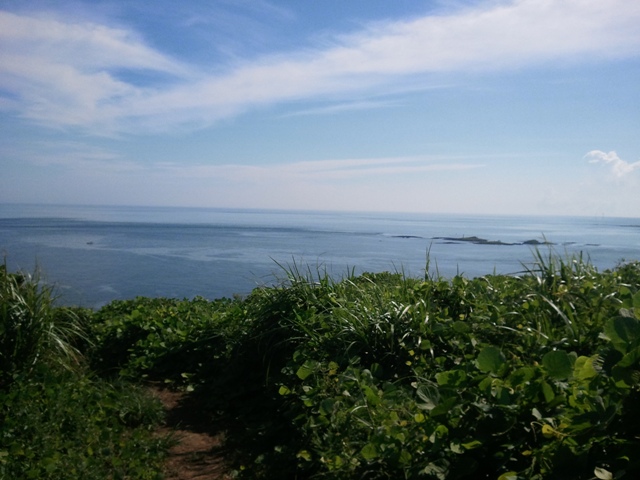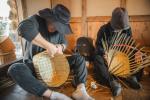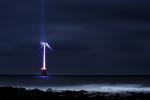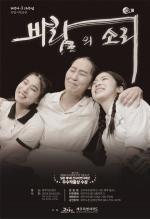- Part 2
 |
||
| The beginnings of Seolmundae's rocky bridge to the mainland. Photo by Anne Hilty | ||
[This article is Part 2 of a 2-part series. For Part 1, see here.]
As with any creator deity, the most significant of all, myths surrounding the figure of Seolmundae Halmang abound.
The theme of worn fabric plays a role in another of her myths. She was said to have struck a bargain with the people of Jeju, in that she would complete their desired bridge to the mainland -- a bridge that her original creation had begun, as rocks jut out into the sea at an area along the northeast coastline near Jocheon -- if they in turn would create new silk clothing for her. (Some later myths refer specifically to undergarments, but this is disputed.)
The people attempted but fell short of this task, collecting 99 bundles of silk instead of the required 100 -- a metaphor for human imperfection or, alternatively, a 'missing holy one' common to the world's myths, and a sense of Jeju's geographic limitations. At the same time, the number nine is considered propitious in the Chinese language which greatly informed that of the Korean region, and appears in other myths and metaphors of Jeju such as the '99 points' in the 'crown' of Seongsan Ilchulbong, a tuff cone off the eastern tip of the island, or the '99 valleys' said to both protect and limit the people of this land.
In some Korean myths of the mainland, clothing when in reference to deity or other mythical creatures is a metaphor for wings or mobility, most significantly the ability to return to their celestial home -- the absence of which renders the otherworldly being earthbound. An earlier myth of Seolmundae refers to the progressive deterioration of her godly garments caused by her stay in this world, clothing which couldn't be repaired because in the Otherworld it would never have deteriorated -- and on earth, the proper materials for its repair thus did not exist.
When the people of Jeju, whom she loved, demanded of her a bridge to the mainland, she ultimately denied their request, in her wisdom preferring that they continue to be self-reliant and remain in the safety of the island which she had created. The people, in their anger and resentment over this denial of their desire for ease of travel to the mainland, rejected and ceased their worship of her, another common theme in Jeju as well as world mythology. Their increasing negativity toward her in turn hastened the deterioration of her garments, proportionately disempowering her and rendering her ever more earthbound.
Her elder brother, in the world of the gods, noted her misery and offered to rescue and return her to her rightful home; she refused, preferring to remain with her beloved Jeju people even if it meant her death. She asked her brother's advice on how to remain with the Jeju people eternally, and was told to heal herself [resolve her sadness] and become water [source of life].
Having emerged from Mount Halla in the form of fire, as the burning lava of the spewing volcano from which Jeju was created, she returned to the island in the form of water, becoming or residing within Muljangeori, a crater lake at 900m above sea level located in Bongjae-dong, retreating beneath its surface and subsequently emerging only as needed by the Jeju people.
The dying god, typically descending to the Underworld and often including rebirth or reincarnation, is a common theme among world mythologies, one of sacrifice for a beloved people. Muljangeori thus became a traditional sacred site to the inhabitants of Jeju, and is today a Ramsar-designated wetland.
Jeju was once crisscrossed with streams, according to myth, but when Seolmundae retreated into Muljangeori the streams followed her, leaving 99 valleys in their place, approximately the same number as that of the coastal villages. It is also said that a dangerous beast roamed the island at that time, but when the valleys emerged and provided protection for the people, the beast departed the island forever. Local legend also purports, however, that because there are only 99 rather than 100 valleys, a universal symbol of insufficiency, "beasts," alternately defined as impressive mammals such as tigers or lions, or as warriors or great leaders, cannot arise from Jeju -- again acknowledging a sense of limitation as a result of positioning.
Another myth refers to Seolmundae's drowning, when she entered a lake to judge her giant size but misjudged its depth; this is also disputed among local scholars, however, as a distortion.
 |
||
| Seongsan Ilchulbong, where Seolmundae is said to have rested her lantern. Photo by Anne Hilty | ||
In addition to those questionable myths earlier mentioned, there are also stories regarding the creation of strong waves by her urine flow, and even a male 'Seolmundae Harubang' [grandfather] who stirred a fish pond with his giant penis, all cited by some local scholars as deliberate distortions which emerged during or after the Joseon era, a repressive period for women as well as shamanism, as attempts to trivialize, render passive and impotent, and ultimately eradicate the Seolmundae mythology. During the Joseon dynasty, females and shamans were systematically disempowered, and female-oriented myths changed to "cheonjiwon ponpuri" or male-dominant legends.
One such widely dispensed myth is that of Seolmundae's having 500 sons of military general status, of her accidental drowning in the giant cauldron which held their dinner, and their subsequent consumption of same. The youngest son, a repeated theme of favored or wise child in Jeju and world mythology, recognized the truth and mourned her death, seen as a mother's self-sacrifice for her sons. While myths with themes of sacrifice and of offspring consuming a parent are common throughout the world, this is reportedly a story developed in modern times and supporting the Neo-Confucian ideals of the Joseon era regarding womanhood and mothers' self-sacrifice, not an original myth.
As with all oral traditions, myths change with time, circumstance, and political as well as social agendas. The Seolmundae myth is no exception in this regard, though it is highly unusual as a creation myth centered on a single goddess figure. It is also arguably the primary basis for the traditionally matrifocal culture with its "strong Jeju woman" motif, deeply internalized through the generations.
What remains is the Jeju people's love of Seolmundae, whether metaphoric or literal -- and their instinctive sense that, though subject to interpretation, she is ever-present and watching over them.
–
Kim Soonie, Jeju native, is a mythologist and Jeju representative of the nation's Cultural Heritage Administration. Anne Hilty is a cultural health psychologist from New York who now makes Jeju Island her home. Interpretation / translation was provided by Han Youngsook, Jeju native and instructor at Jeju National University.
by Kim Soonie and Anne Hilty eastwest.psyche@gmail.com
<저작권자 © 제주위클리 무단전재 및 재배포금지>






